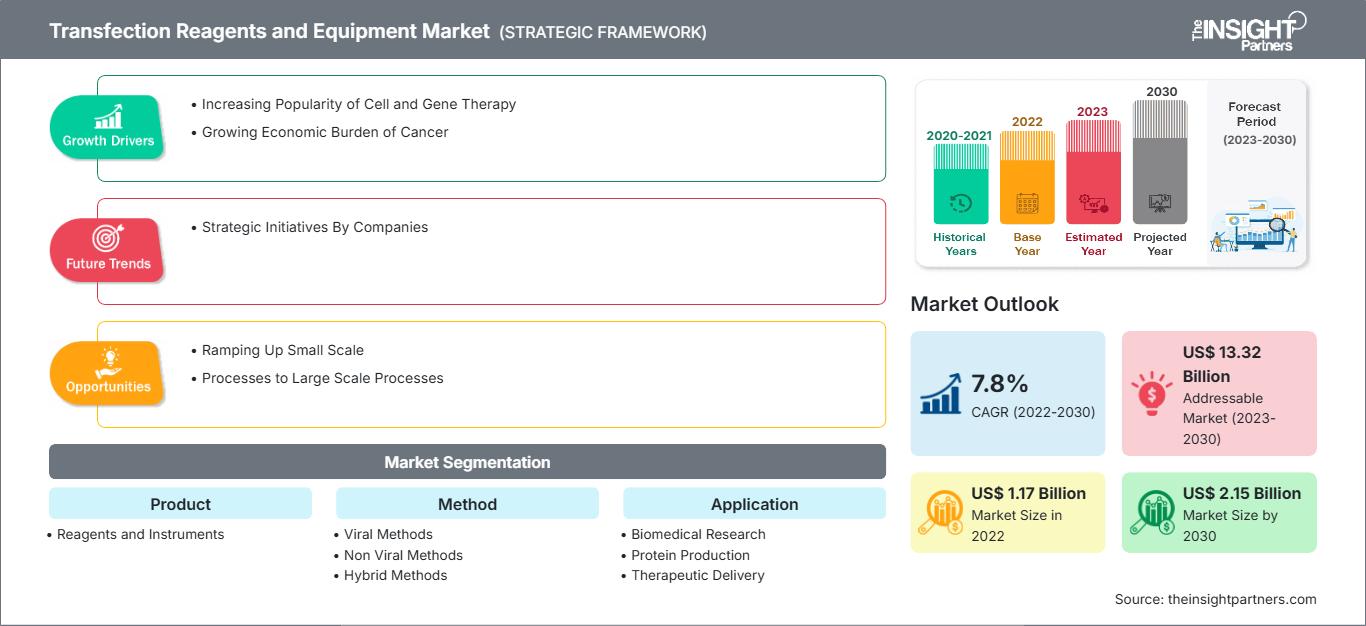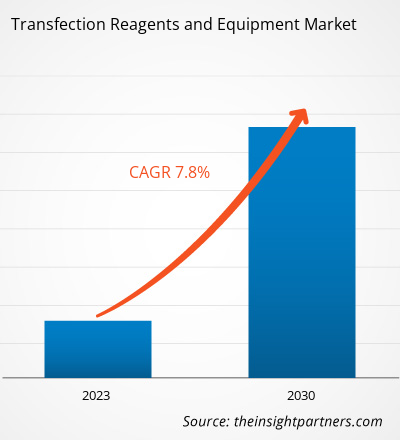[研究报告] 转染试剂和设备市场预计将从2022年的11.7079亿美元增长到2030年的21.4503亿美元;预计2022年至2030年的复合年增长率为7.8%。
市场洞察和分析师观点:
转染试剂和设备市场规模的扩张归因于慢性病病例的增加,以及细胞和基因治疗的日益普及。转染是通过化学、物理和生物手段将外来颗粒和核酸转移到细胞中的过程。转染试剂用于提高基因实验的有效性,该实验是应用基因治疗领域进行实质性研究的一部分。在所有转染实验中,必须谨慎选择将化合物输送到细胞中的方法。病毒介导的转染已显示出相当高的有效性,转染产物可以诱导显著的免疫反应。然而,人们已经开发出化学替代品来抑制该技术中使用病毒所带来的不良影响。
增长动力与挑战:
细胞和基因疗法的生产是一个复杂的过程,这使得其执行和监控至关重要。生物技术的进步使得个性化治疗在众多适应症的治疗中得到应用。细胞和基因疗法主要用于治疗神经系统疾病、癌症和遗传性疾病等慢性疾病。细胞和基因疗法的显著优势包括靶向治疗、更快更有效的康复以及更少的副作用。由于美国食品药品监督管理局 (FDA) 批准的产品种类繁多,细胞和基因疗法在世界范围内得到了广泛应用。例如,FDA 于 2022 年批准了 Ferring Pharmaceuticals A/S 生产的腺病毒 ADSTILADRIN。这种重组腺病毒 (rAd-IFNa/Syn3) 将人干扰素 alfa-2b cDNA 输送到膀胱上皮中,以治疗患有某些类型膀胱癌的患者。 2022年,美国食品药品监督管理局(FDA)批准了由杨森生物技术公司(Janssen Biotech, Inc.)生产的CARVYKTI。CARVYKTI是一种利用慢病毒改造的自体CAR-T细胞,用于攻击表达BCMA的肿瘤细胞,从而治疗某些类型的复发性或难治性多发性骨髓瘤。
根据伦敦大学学院(UCL)2020年发表的文章《基因治疗流程变革评估框架:瞬时转染与稳定生产细胞系的比较》,目前有423项正在进行的临床试验用于测试基因治疗产品。如今,科学家采用转染技术来生产这些疗法。因此,细胞和基因治疗活动的普及推动了转染程序的数量,进而推动了转染试剂和设备市场的增长。
自定义此报告以满足您的要求
您将免费获得任何报告的定制,包括本报告的部分内容,或国家级分析、Excel 数据包,以及为初创企业和大学提供超值优惠和折扣
转染试剂和设备市场: 战略洞察

-
获取本报告的主要市场趋势。这个免费样本将包括数据分析,从市场趋势到估计和预测。
持续致力于开发提升小规模转染工艺的方法,这为转染试剂和设备市场的增长提供了机遇。转染是开发病毒载体(包括腺病毒、腺相关病毒和慢病毒)的复杂步骤。随着生产工艺的扩大,瞬时转染也必须随之提升。工艺设备供应商、药物开发商和原材料供应商正致力于合作,开发经济高效、实用且可平台化的解决方案,以快速开发和扩大病毒载体生产工艺。通过规划好材料用量以及转移和混合时间,小规模转染多个质粒细胞变得可行。由于大多数公司仅具备实验室级别的转染经验,因此扩大规模需要具备工业化转染步骤的经验。然而,将工艺规模扩大到更大规模所需的细胞培养基和转染试剂的量可能不切实际,这凸显了优化的必要性。
尽管如此,近年来随着病毒载体需求的激增,扩大生产规模已变得普遍。由于大规模转染工艺面临诸多挑战,提高产量的最佳方法是缩短工艺流程,而不是扩大工艺规模。这种自上而下的方法可以清晰地识别在工业层面影响工艺的条件,例如转染复合溶液的用量。这种方法还有助于工艺优化和决策。
报告细分和范围:
转染试剂和设备市场根据产品、模式、应用、最终用户和地域进行细分。根据产品,市场分为试剂和设备。根据模式,转染试剂和设备市场分为病毒法、非病毒法和混合法。就应用而言,转染试剂和设备市场分为生物医学研究、蛋白质生产和治疗递送。按最终用户划分,转染试剂和设备市场分为学术和研究机构以及制药和生物技术公司。按地域划分,转染试剂和设备市场细分为北美(美国、加拿大和墨西哥)、欧洲(英国、德国、法国、意大利、西班牙、俄罗斯和欧洲其他地区)、亚太地区(中国、日本、印度、韩国、澳大利亚、东南亚和亚太其他地区)、中东和非洲(阿联酋、沙特阿拉伯、南非和中东及非洲其他地区)以及南美洲和中美洲(巴西、阿根廷和南美洲和中美洲其他地区)。
细分分析:
2022 年,基于模式的非病毒方法细分市场在转染试剂和设备市场中占据了更大的份额。非病毒方法领域将在2022年至2030年期间录得更高的复合年增长率。非病毒转染方法可进一步分为物理/机械方法和化学方法。常用的物理/机械转染方法包括电穿孔、声穿孔、磁转染、基因微注射和激光照射。电穿孔是一种常用的物理转染方法,它利用电压暂时增加细胞膜通透性,使外来核酸进入细胞。超声辅助转染或声穿孔涉及使用微泡技术在细胞膜上制造孔洞以促进遗传物质的转移,而激光照射辅助转染则使用激光束在质膜上制造小孔,以允许外来遗传物质进入。化学转染方法可进一步分为基于脂质体或非基于脂质体。脂质体转染试剂能够形成带正电荷的脂质聚集体,这些聚集体能够与宿主细胞的磷脂双层顺利结合,从而使外来遗传物质以最小的阻力进入细胞。非脂质体转染试剂可分为几类:磷酸钙、树枝状聚合物、聚合物、纳米颗粒和非脂质体脂质。病毒载体系统包括逆转录病毒、腺病毒 (AdV)、腺病毒相关病毒 (AAV)、慢病毒 (LV) 和噬菌体。目前市面上大多数基因治疗药物都使用病毒作为载体。虽然病毒载体存在免疫原性高、安全隐患和生产困难等缺点,但其较高的转染效率为基因递送提供了独特的优势。一般来说,逆转录病毒只能用于转染分裂细胞,而腺病毒、腺相关病毒(AAV)和疱疹病毒则可用于转染分裂细胞和非分裂细胞。
2022年,试剂细分市场(按产品划分)在转染试剂和设备市场中占据了更大的份额。试剂细分市场将在2022年至2030年期间录得更高的复合年增长率。随着产品发布的激增以及对扩大转染工艺的关注,对转染试剂的需求正在增长。2021年8月,Mirus Bio推出了TransIT VirusGEN GMP转染试剂和增强剂产品线,以支持用于基因治疗开发和相关工艺的病毒载体制造。TransIT VirusGEN GMP转染试剂旨在增强将转移疫苗DNA递送至悬浮和贴壁HEK 293细胞的能力,从而更好地生产重组AAV和慢病毒载体。为了提高载体的生产能力,人们越来越注重推出符合 GMP 标准的转染试剂,这进一步推动了转染试剂市场的进步。
根据应用,生物医学研究领域在 2022 年占据了转染试剂和设备市场的最大份额。预计该领域市场在 2022 年至 2030 年期间的复合年增长率最快。2022 年,按最终用户划分,学术和研究机构领域在转染试剂和设备市场中占有更大的份额。预计制药和生物技术公司领域在 2022 年至 2030 年期间的复合年增长率将更高。
区域分析:
根据地域,转染试剂和设备市场分为北美、欧洲、亚太地区、中东和非洲以及南非。中美洲。北美是全球转染试剂和设备市场增长的最大贡献者。预计亚太地区将在2022年至2030年期间实现转染试剂和设备市场的最高复合年增长率。细胞和基因疗法 (CGT) 用于治疗患有严重和罕见疾病且治疗需求尚未得到满足的患者。CGT 的生产是一个高度复杂的过程,基础设施和专业知识不足是主要的限制因素。与中间体和最终产品相关的物流挑战限制了企业的 CGT 生产能力。CGT 的生产过程包括通过“单采术”提取自体细胞,将其送至专门的实验室,然后送回诊所进行患者给药,所有这些过程都必须在严格的质量控制下进行。迄今为止,美国食品药品监督管理局 (FDA) 仅批准了 7 种 CGT 药物,而新产品的研发管线已达到约 1,200 种实验性疗法。其中一半处于 II 期临床试验阶段。鉴于这些前景,《化学与工程新闻报告 2023》指出,细胞和基因疗法的年销售额预计将分别增长 15% 和 30% 左右。
许多制造商与 Labcorp、Lonza 和 Catalent 等合同开发制造组织 (CDMO) 接洽,以克服其 CGT 产品生产和商业化过程中遇到的障碍。Lonza 已投资约 920 万美元,用于增强其细胞和基因疗法的生产能力。CDMO 的此类举措正在促进美国转染试剂和设备市场的增长。
转染试剂和设备
转染试剂和设备市场区域洞察The Insight Partners 的分析师已详尽阐述了预测期内影响转染试剂和设备市场的区域趋势和因素。本节还讨论了北美、欧洲、亚太地区、中东和非洲以及南美和中美洲的转染试剂和设备市场细分和地域分布。
转染试剂和设备市场报告范围
| 报告属性 | 细节 |
|---|---|
| 市场规模 2022 | US$ 1.17 Billion |
| 市场规模 2030 | US$ 2.15 Billion |
| 全球复合年增长率 (2022 - 2030) | 7.8% |
| 历史数据 | 2020-2021 |
| 预测期 | 2023-2030 |
| 涵盖的领域 |
By 产品
|
| 覆盖地区和国家 |
北美
|
| 市场领导者和主要公司简介 |
|
转染试剂和设备市场参与者密度:了解其对业务动态的影响
转染试剂和设备市场正在快速增长,这得益于终端用户需求的不断增长,而这些需求的驱动因素包括消费者偏好的演变、技术进步以及对产品优势的认知度的提升。随着需求的增长,企业正在扩展产品线,不断创新以满足消费者需求,并抓住新兴趋势,从而进一步推动市场增长。

- 获取 转染试剂和设备市场 主要参与者概述
行业发展与未来机遇:
转染试剂和设备市场主要参与者的突出举措之一如下:
- 2023年9月,Polyplus 推出了用于慢病毒载体 (LV) 合成的 FectoVIR-LV 转染试剂,可供预订。与此同时,该公司还免费扩展了新的实验设计 (DoE) 服务,以优化转染条件,从而在悬浮系统中获得更高的 LV 载体滴度和质量。在悬浮 HEK-293 细胞系统中,FectoVIR-LV 是新一代转染试剂,可增强 LV 的生产。该试剂经过精心设计,可减少络合体积并提高复合物稳定性,同时保持其无动物成分,使其适合大规模生产。
竞争格局和主要公司:
转染试剂和设备市场的一些知名公司包括赛默飞世尔科技公司 (Thermo Fisher Scientific Inc.)、普洛麦格公司 (Promega Corporation)、Qiagen NV、默克集团 (Merck KGaA)、龙沙集团 (Lonza Group)、罗氏公司 (F.Hoffmann-La Roche Ltd)、Bio-Rad Laboratories Inc.、Mirus Bio LLC、MaxCyte Inc 和 Polyplus-Transfection SA。这些公司专注于新产品的推出和地域扩张,以满足全球不断增长的消费者需求,并通过特色产品组合扩展其产品范围。他们的全球业务使他们能够服务于庞大的客户群,从而促进市场扩张。
- 历史分析(2 年)、基准年、预测(7 年)及复合年增长率
- PEST和SWOT分析
- 市场规模、价值/数量 - 全球、区域、国家
- 行业和竞争格局
- Excel 数据集
近期报告
客户评价
购买理由
- 明智的决策
- 了解市场动态
- 竞争分析
- 客户洞察
- 市场预测
- 风险规避
- 战略规划
- 投资论证
- 识别新兴市场
- 优化营销策略
- 提升运营效率
- 顺应监管趋势






















 获取免费样品 - 转染试剂和设备市场
获取免费样品 - 转染试剂和设备市场